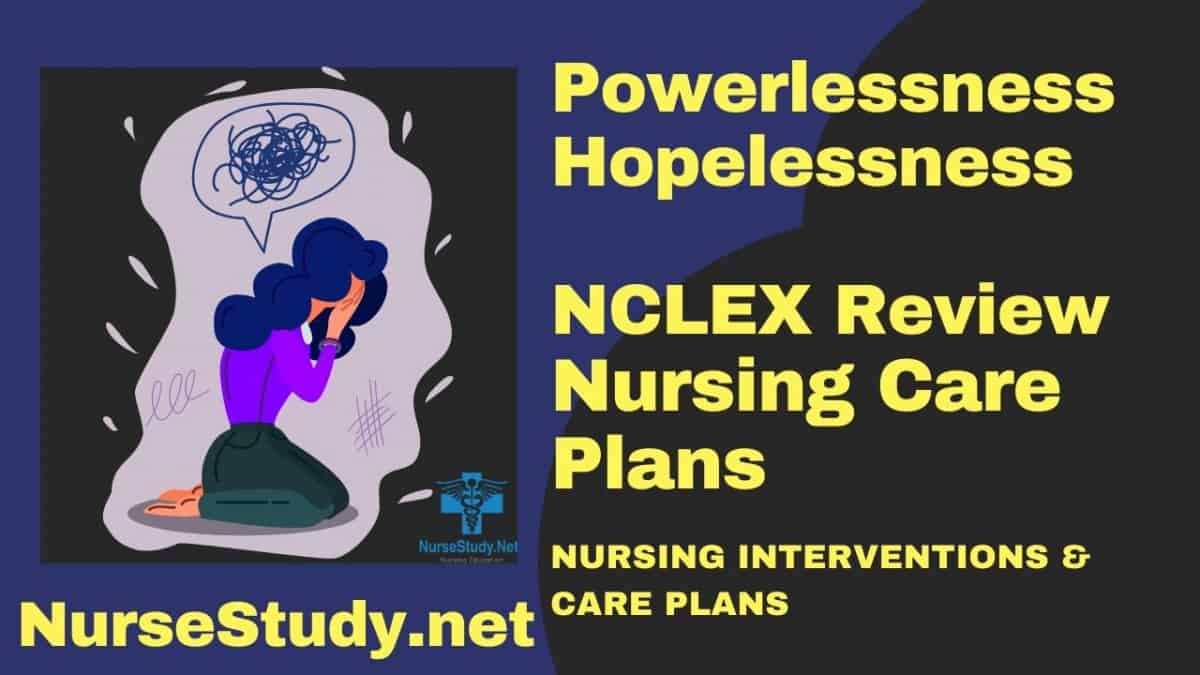Powerlessness in nursing refers to a patient’s perceived lack of control over their health outcomes, treatment decisions, or life circumstances. This state often emerges during hospitalization or when facing chronic illness, where patients feel they’ve lost autonomy over their daily activities and healthcare choices. Understanding and addressing powerlessness is crucial as it can significantly impact patient recovery, treatment adherence, and overall health outcomes.
Causes (Related to)
- Hospitalization and institutional care routines
- Chronic or terminal illness diagnosis
- Complex treatment regimens
- Limited understanding of medical conditions or treatment
- Physical limitations or disability
- Loss of independence in activities of daily living
- Healthcare system complexity
- Language or cultural barriers
- Previous negative healthcare experiences
Signs and Symptoms (As evidenced by)
- Expression of frustration over lack of control
- Passivity in decision-making
- Reluctance to express preferences
- Depression or anxiety
- Non-compliance with treatment plans
- Anger or agitation
- Withdrawal from care discussions
- Expressed helplessness
- Difficulty setting goals
- Reluctance to attempt self-care activities
Expected Outcomes
- Patient will demonstrate increased participation in care decisions
- The patient will express feeling more control over their situation
- The patient will engage in self-care activities within their capabilities
- The patient will verbalize understanding of their condition and treatment
- The patient will utilize available resources and support systems
Nursing Assessment
Evaluate patient’s understanding of their condition
- Assess knowledge gaps about diagnosis and treatment
- Identify misconceptions about their role in recovery
Assess support systems
- Determine family involvement and availability
- Identify cultural and spiritual resources
Review previous coping mechanisms
- Evaluate past successful strategies
- Identify ineffective patterns
Assess decision-making capacity
- Determine cognitive ability
- Evaluate mental status
Document physical limitations
- Assess functional abilities
- Identify areas where assistance is needed
Nursing Interventions
Promote patient autonomy
- Involve patient in care planning
- Offer choices whenever possible
- Respect patient preferences
Provide information and education
- Use clear, simple language
- Verify understanding
- Provide written materials when appropriate
Set achievable goals
- Break down tasks into manageable steps
- Celebrate small accomplishments
- Adjust goals as needed
Enhance communication
- Listen actively
- Validate feelings
- Maintain open dialogue
Build trust
- Be consistent
- Follow through on commitments
- Demonstrate respect for the patient’s values
Nursing Care Plans
Nursing Care Plan #1
Nursing Diagnosis Statement: Powerlessness related to hospitalization and lack of knowledge regarding the treatment plan.
Related Factors:
- Limited understanding of medical procedures
- Unfamiliar hospital environment
- Complex treatment regimen
Nursing Interventions and Rationales:
- Provide comprehensive education about the treatment plan
Rationale: Increases understanding and sense of control - Include the patient in daily care planning
Rationale: Promotes autonomy and engagement - Teach simple relaxation techniques
Rationale: Helps manage anxiety and stress
Desired Outcomes:
- Patient will verbalize understanding of treatment plan
- The patient will participate in care decisions
- The patient will demonstrate reduced anxiety
Nursing Care Plan #2
Nursing Diagnosis Statement: Powerlessness related to chronic illness and physical limitations.
Related Factors:
- Progressive disease process
- Decreased mobility
- Loss of independence
Nursing Interventions and Rationales:
- Assist in identifying activities patient can still perform independently
Rationale: Maintains a sense of control - Teach adaptive techniques for self-care
Rationale: Promotes independence - Connect patient with support groups
Rationale: Provides peer support and coping strategies
Desired Outcomes:
- The patient will demonstrate the use of adaptive equipment
- The patient will express increased confidence in self-care
- The patient will participate in support group activities
Nursing Care Plan #3
Nursing Diagnosis Statement: Powerlessness related to language barriers and cultural differences.
Related Factors:
- Communication difficulties
- Unfamiliarity with the healthcare system
- Cultural beliefs about healthcare
Nursing Interventions and Rationales:
- Utilize professional interpreters
Rationale: Ensures accurate communication - Incorporate cultural practices when possible
Rationale: Respect patient values - Provide culturally appropriate educational materials
Rationale: Enhances understanding
Desired Outcomes:
- The patient will express feeling understood
- The patient will demonstrate improved communication
- The patient will engage in culturally appropriate care
Nursing Care Plan #4
Nursing Diagnosis Statement: Powerlessness related to complex treatment decisions.
Related Factors:
- Multiple treatment options
- Uncertainty about outcomes
- Limited healthcare literacy
Nursing Interventions and Rationales:
- Provide decision-making tools
Rationale: Facilitates informed choices - Explain the pros and cons of each option
Rationale: Increases understanding - Allow time for questions and discussion
Rationale: Promotes active participation
Desired Outcomes:
- Patients will make informed decisions about care
- The patient will express confidence in choices
- The patient will demonstrate an understanding of the options
Nursing Care Plan #5
Nursing Diagnosis Statement: Powerlessness related to previous negative healthcare experiences.
Related Factors:
- Past trauma in healthcare settings
- Mistrust of healthcare providers
- Fear of medical procedures
Nursing Interventions and Rationales:
- Establish therapeutic relationship
Rationale: Builds trust - Validate past experiences
Rationale: Acknowledges patient’s feelings - Develop safety signals
Rationale: Provides control during procedures
Desired Outcomes:
- The patient will express increased trust in the healthcare team
- The patient will communicate needs effectively
- The patient will demonstrate reduced anxiety
References
- Ballová Mikušková E, Teličák P. Unfounded beliefs, distress and powerlessness: A three-wave longitudinal study. Appl Psychol Health Well Being. 2024 Nov;16(4):1539-1564. doi: 10.1111/aphw.12542. Epub 2024 Apr 10. PMID: 38600714.
- Fine-Goulden MR. Power and powerlessness in a pandemic. Pediatr Res. 2022 Mar;91(4):1004-1005. doi: 10.1038/s41390-021-01480-z. Epub 2021 Apr 16. PMID: 33864013; PMCID: PMC9064792.
- Giger JN. Feelings of powerlessness and the elderly. J Natl Black Nurses Assoc. 2009 Dec;20(2):vii-viii. PMID: 20364719.
- Walding MF. Pain, anxiety and powerlessness. J Adv Nurs. 1991 Apr;16(4):388-97. doi: 10.1111/j.1365-2648.1991.tb03427.x. PMID: 2061501.
- Wallerstein N. Powerlessness, empowerment, and health: implications for health promotion programs. Am J Health Promot. 1992 Jan-Feb;6(3):197-205. doi: 10.4278/0890-1171-6.3.197. PMID: 10146784.
